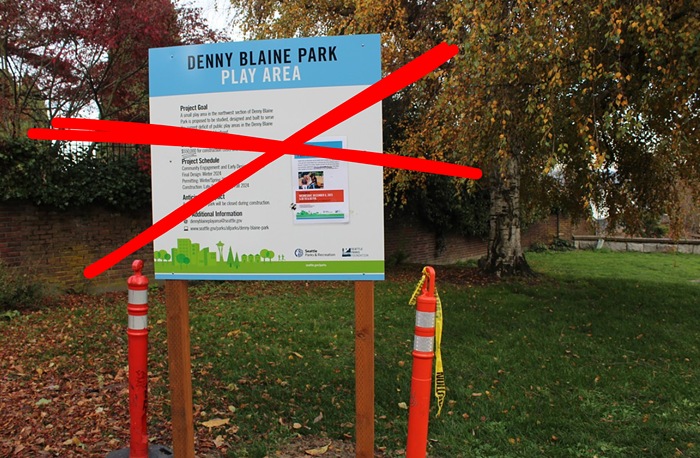
The King County Sheriff’s Office (KCSO) came under fire Tuesday morning after a report was released that found the law enforcement agency did an outstandingly bad job investigating a 2017 officer-involved shooting that left a Des Moines, Washington teen dead.
The report analyzed KCSO’s actions following the death of Mi’Chance Dunlap-Gittens, a 17-year-old boy shot in the back of the head during a hastily arranged sting operation gone wrong in January of 2017. (More about that sting operation at the bottom of this post.)
KCSO subsequently investigated the deadly shooting, but their internal investigation was riddled with errors and failures, according to the report out today. The report found that KCSO waited weeks before interviewing the three officers who fired their weapons, failed entirely to interview officers who supervised the undercover operation, and failed to analyze whether the use of deadly force was needed. The report also found reason to believe the death was set off by one sergeant accidentally firing his weapon.
The report out today was commissioned by the King County Office of Law Enforcement Oversight (OLEO) and conducted by OIR Group, a California-based consultant. Michael Gennaco, the chief author of the report, said it was particularly troubling that KCSO failed to implement any of the lessons they themselves had found while reviewing the death in their own internal investigation.
“So, the result is that all of those good ideas… never got implemented,” Gennaco said Tuesday morning during a hearing at the King County Law and Justice Committee.
KCSO refused to cooperate with OLEO’s report, declining to provide any personnel for interviews. Gennaco said in his report that he had conducted hundreds of police reviews within jurisdictions across the country without being refused access for interviews.
King County Sheriff Mitzi Johanknecht did not attend Tuesday’s county council hearing, but she sent the council a letter saying she was on a previously planned trip to Washington, D.C.
Sgt. Ryan Abbot, a spokesperson for the KCSO, told The Stranger Tuesday morning that the report’s timing was “unfortunate” given the pending civil lawsuit brought against KCSO by the victim’s family.
“Some of the information contained in the report is the subject of a dispute in a pending lawsuit and will be addressed in that context,” Abbot said in an e-mail.
King County Council members were not convinced that KCSO should wait until that civil litigation is over to resolve its problems. Council Member Girmay Zahilay, chair of the Law and Justice Committee that heard the report Tuesday, said he will move forward quickly on pushing for reforms at the office.
“We will fight for the changes listed in this report,” said Zahilay. "We will not wait until civil litigating is over because justice cannot wait."
Council Member Dave Upthegrove said that reforms should be pushed forward, even as the council was facing pressure to cancel Tuesday’s meeting.
“The best thing we can do is put sunlight on this report and the actions that took place and I know there was pressure to not have this meeting,” Upthegrove said. “I think one of the best things we can do to honor [Dunlap-Gittens's] memory is to seek to implement the recommendations of this report.”
Council Member Rod Dembowski even went as far as to say that the report might give a reason to change the county’s laws so that sheriffs can be appointed rather than elected every four years.
“When you see three years later, recommendations quote, 'dying on the vine,' no changes on them made… we may have more than just a problem with current leadership but a structural problem,” Dembowksi said. “If something isn’t going right there’s a lot of time between four years.”
The county council plans on revisiting the report at a meeting on February 20.

Police Union Tried to Block Report
This latest report from OLEO clearly struck a nerve inside the sheriff’s office. The King County Police Officer’s Guild (KCPOG), a union that represents sheriff’s deputies, tried to block the report, asking the sheriff to “stop the release of the report” in a February 4 letter released by the KCSO.
KCPOG has filed a labor grievance over the report and claimed in a letter to the sheriff that OLEO’s work violates their collective bargaining agreement because the report was conducted by an outside consultant. KCPOG said that OLEO’s consultant “should never have been provided the information on which to proffer the report in the first place.”
The union also claimed that this report was not a systemic review because it looked at only one instance of use of force rather than looking at all police-involved killings.
Gennaco said Tuesday that examining one individual case is often an effective way to examine the entire police oversight system.
“Officer involved shootings are fortunately low-frequency but very high-risk situations,” Gennaco said. “So often times it is one case that can provide a window into the decision making, the investigative strength, and the review strength from the agency which the [incident] occurred.”
It does not appear that KCSO tried to block the report’s release, but Johanknecht appears to agree with the union’s characterization. In her Monday letter to the King County Council, she said that OLEO’s review was “adversarial” and claimed that OLEO’s report violated the county’s police union contracts.
“Imposing an opinion or belief without using the well tested collective bargaining process severely undermines collaboration and creates a lack of trust,” Johanknecht said in the letter. “Until recently, the OLEO had conducted its systemic reviews in accord with the plain language of the King County Code and in keeping with past practice. It is challenging to work in an environment where these long standing concepts are disregarded.”
This report isn’t the first time Johanknecht has interfered with OLEO’s ability to conduct oversight over her office. In 2018, Johanknecht blocked OLEO from accessing the county’s database of misconduct complaints following a string of OLEO reports that were critical of her office. Johanknecht’s chief of staff said OLEO’s staff lacked the necessary background checks to gain access to the pivotal database of misconduct complaints.
Cops Are Sometimes More Dangerous than Suspects
OLEO’s report was aimed at studying the sheriff’s entire system of conducting oversight—rather than just studying the death of Dunlap-Gittens—but in studying this one particular death they found a number of problematic occurrences that led up to the 17-year-old’s killing.
The report even suggests that the shooting may have been set off by one officer accidentally firing his weapon.
Dunlap-Gittens was killed during an undercover operation. Sheriff’s deputies were trying to catch a person who allegedly killed the son of a Seattle police officer. One of Dunlap-Gittens’s friends was suspected as a “person of interest” in the death of the cop’s son, so deputies began impersonating an underage female online in an attempt to lure the individual. The cops set up a meeting with Dunlap-Gittens’s friend at a location in Des Moines under the pretense that the underage female was going to purchase alcohol.
Sheriff’s deputies showed up to the scene with two plainclothes police officers in the front of an unmarked van while three cops hid in the back. When the “person of interest” arrived, the cops were surprised to see that Dunlap-Gittens was there as well.
As the two young men approached the officer’s van, the three cops jumped out and one immediately noticed that the Dunlap-Gittens and his friend were armed, according to the OLEO report. That officer, identified only as Sergeant A in the OLEO report, fired his gun and then two other officers, identified as Detective B and Detective C, fired their weapons and struck Dunlap-Gittens multiple times, including in the back of the head.
Dunlap-Gittens died shortly after the shooting; his friend escaped but was later apprehended. Both young men were later cleared of any connection to the death of the cop’s son that deputies were investigating.
The OLEO found that KCSO’s review never even questioned the detective’s decision to open fire. When the independent report looked into the rationale for the shooting, they found flaws both in the reasons given by the officers and exactly how the shooting took place.
During the shooting, Sergeant A opened fire first, with one single shot, and then Detective B fired three rounds and Detective C fired eight rounds. Four of these rounds missed the fleeing suspects and struck a nearby apartment building, landing in a bathroom and a hallway.
Officers are trained that if they encounter a deadly force situation they should “continue firing until the threat has ended,” according to the report. KCSO never asked Sergeant A why he fired only one shot, but OLEO’s report finds that it may have been accidental.
“[A]n alternative plausible scenario neither addressed during the interview of Sergeant A nor during the review process is whether the one shot he fired was not intentional but an accidental discharge of his weapon,” the report states.
The independent report also questions the rationale the three officers gave for the shooting, and why KCSO failed to question the deputies’ stated reasons. The report found that KCSO’s review process never included a detailed assessment of whether “the level of threat posed by Dunlap-Gittens at that point was sufficient for deadly force to be deployed.”
The deputies gave three reasons for the shooting: that Dunlap-Gittens had looked back while fleeing, which meant he was an aggressor; that Dunlap-Gittens was gaining a tactical advantage by moving to higher ground; and that Dunlap-Gittens posed a threat to the public if the men escaped.
The independent report questioned the validity of all three of these reasons. The report said that Dunlap-Gittens looking back was more consistent with “a reflexive effort to see what the deputies were doing—and not an attempt to engage and aggress them.” The report said any worry over gaining “higher ground” was not justification to fire weapons.
Interestingly, the report found that the officers themselves posed a bigger danger to the public than the two fleeing young men, considering the deputies fired bullets that landed in a innocent bystander’s home (emphasis added):
Here, and by all objective accounts, the two subjects were only intent on escaping the threat of arrest or physical harm posed by three armed men who jumped out of the back of a van. In fact, in this case and as detailed below, the stray rounds by the detectives that entered an occupied apartment created a greater threat to innocent civilians than any actions taken by the subjects.
James Bible, an attorney representing the father of Dunlap-Gittens in a civil lawsuit against the county, said he was surprised to see how candid OLEO’s report was.
“Traditionally I’m in a place where I’m expecting the reports are most likely to absolve the officers of any wrongdoing,” Bible told The Stranger. “This report is unique because it authentically talks about significant errors within the King County Sheriff’s Office and real work that needs to be done to improve accountability. And points out the young men were not a threat to the officers.”
Deborah Jacobs, the director of OLEO, told the King County Council on Tuesday morning that reforms need to happen to protect public safety.
“We wish we could have issued our recommendations sooner because our recommendations are vital to public safety,” Jacobs said.
Gennaco, the author of the report, pointed out that deadly police shootings have continued since Dunlap-Gittens’s death.
“Since this incident there unfortunately have been other deadly force incidents and we will never know if those reforms that didn’t get implemented three years ago might have changed the results of these subsequent shootings,” Gennaco said.



















